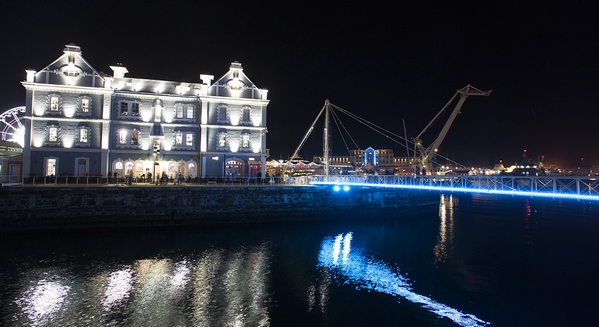Royal Philips, the global leader in LED lighting, kicked off its sixth consecutive Cape Town to Cairo roadshow (http://www.philips.com/C2CAfrica) by lighting up the iconic Clock Tower, the Port Captain’s building and the Swing Bridge, at the popular V&A Waterfront (http://www.waterfront.co.za) in Cape Town, South Africa. This year’s roadshow theme, ‘Sustainability through Innovation’ is more pertinent than ever before as the company spearheads the LED lighting revolution in Africa with smart lighting solutions designed for the continent.
 |
|
Cape Town Clock Tower, Port Captains Building & Swing Bridge. (All Photos Courtesy of African Press Organization) |
LED lighting solutions to improve energy performance in public spaces
As a contribution to enhancing the attractiveness of iconic monuments across Africa while reducing energy consumption in parallel (a project that Philips started during last year’s roadshow), Philips has installed its latest Vaya LED lighting solutions (http://www.colorkinetics.com/vaya) combining warm and cool daylight colors to create an almost mythical atmosphere around the Clock Tower, the Port Captain’s building and the Swing Bridge that bring history to life. The LED Lighting installed has a lifetime of up to 50,000 (fifty thousand) hours and is entirely cutting edge, with each luminaire having its own IP address; a precursor to the future of connected lighting in an environment steeped in history.
Lighting is thought to consume around 15%(1) of the total electricity output of an industrialized economy like South Africa; it has been calculated that approximately half of a city’s energy bill goes on lighting – for public offices, schools and outdoor environments. We can make significant savings – on average 40% – simply by switching to energy-efficient lighting technologies.
With electricity use a constant concern across the African continent, workable and sustainable solutions are needed now more than ever. Driven by an increase in urbanization and transformation in Africa, a tremendous opportunity for economic and social development exists. However, large scale growth also presents huge challenges, specifically with regard to energy. Energy efficiency is crucial to achieving smart cities of the future that are livable, safe and also aesthetically pleasing.
 |
|
Cape Town Clock Tower, Port Captains Building & Swing Bridge. |
Illuminating South Africa’s oldest sea-faring monuments
The V&A Waterfront is a very popular destination for international visitors and locals in Cape Town; the illumination of these iconic monuments at the Waterfront adds to the beautification of the entire area.
 |
|
Cape Town Clock Tower. |
The Clock Tower
The stately octagonal Victorian, Gothic-style Clock Tower (http://www.gatewayguides.co.za/Gateway_Guides/V&A_Waterfront_files/V&A Waterfront.pdf?_sm_au_=irVFPPfS4ffTW7tq) was built in 1883 and was the Port Captain’s first office in the newly constructed Cape Town harbour. It housed the tide gauge mechanism which worked by a shaft connected to the sea. It also contained all the instruments that the Port Captain needed such as a clock for ships to see the correct time, signal flags, Morse lamps and a telescope.
 |
|
Cape Town Clock Tower, Port Captains Building & Swing Bridge illuminated in a red hue. |
The Port Captain’s building
With the rapid growth of the harbour, a beautiful gabled building was constructed in 1904 to house the Port Captain who till then operated from the Clock Tower.
“The spectacular lighting of the Clock Tower, the Port Captain’s building and the Swing Bridge demonstrates the incredible advances that are being made in the efficiency and beauty of LED illumination”, says Thierry Boulanger, Vice President and General Manager, Philips Lighting Africa. “LED lighting innovations provide completely new opportunities to policy makers and governments to enhance city beautification and at the same time contribute to energy saving. We are extremely proud to see how Philips’ lighting solutions are contributing to improving the attractiveness of these iconic monuments on the V&A waterfront while reducing energy consumption”.
 |
|
Cape Town Clock Tower, Port Captains Building & Swing Bridge when LEDs turn blue. |
The advantages of the Philips Vaya LED lighting solutions (http://www.colorkinetics.com/vaya) provided at these monuments include:
• Dynamic lighting that makes it possible to adjust the atmosphere of the site (change of intensity and color).
• A longer lifespan of the installation: around fifty thousand (50,000) hours compared to twelve thousand (12,000) hours with conventional lighting.
• A reduction in maintenance costs: LED luminaires require little maintenance, while at the same time they cut energy consumption by 80% compared to conventional lighting.
“The lighting of the Port Captain’s building, the historic Clock Tower and the Swing Bridge goes a long way in beautifying aspects of the V&A Waterfront,” states Colin Devinish, Executive for Operations, V&A Waterfront. “As a destination popular with international visitors and frequented by locals we are constantly striving to improve and enhance this important part of South African history; collaborating with Philips was a win-win.”
First stop on the sixth Cape Town to Cairo roadshow
Cape Town is the first stop on Philips’ annual pan-African Cape Town to Cairo roadshow (http://www.philips.com/C2CAfrica) which will cover 12,000 km across 11 cities and 8 countries over a period of 4.5 months. The roadshow has gained significant momentum over the past five years, allowing Philips to get to the heart of some of the key issues facing Africa – advancing healthcare access, leading the LED lighting revolution, and providing products and solutions that meet the aspirational needs of the rising middle class.
This year too, while driving the conversation around sustainable energy solutions, Philips has pledged to illuminate iconic national monuments or provide road and street illumination with digital LED technology, leaving behind a permanent legacy while reducing energy consumption by up to 80% compared to conventional lighting.
The next stop on the roadshow will be Johannesburg on 13 – 14, May 2015.
Join the Cape Town to Cairo journey via Twitter @philipsSafrica or visit www.philips.com/C2CAfrica.
(1) Lighting Africa: https://www.lightingafrica.org/
Distributed by APO (African Press Organization) on behalf of Royal Philips.





 CN
TW
EN
CN
TW
EN










